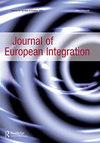The European Union’s transformation after Russia’s attack on Ukraine
IF 3.1
1区 社会学
Q1 INTERNATIONAL RELATIONS
引用次数: 2
Abstract
ABSTRACT Russia’s invasion of Ukraine on 24 February 2022 shattered any remaining illusions that closer economic integration with Europe would lead Russia, over time, towards democracy at home and peaceful coexistence with its neighbors abroad. It reinvigorated the North Atlantic Treaty Organization (NATO) and jolted the European Union (EU) into cutting off trade and energy ties with Russia, while welcoming a massive flow of refugees from war-torn Ukraine. It empowered Central and East European states in the EU, reignited enlargement debates, and shifted NATO and Europe’s borders to the north and east. Introducing a special issue, this article argues that the EU’s peace through integration strategy has always existed side by side with NATO’s peace through strength approach, in a broader European project with blurred boundaries. This war may force the EU to solidify its borders between an internal zone of integration and an external zone of strength projection and geopolitics.俄罗斯袭击乌克兰后欧盟的转变
俄罗斯在2022年2月24日入侵乌克兰,粉碎了任何残存的幻想,即随着时间的推移,与欧洲更紧密的经济一体化将使俄罗斯走向国内民主,与国外邻国和平共处。它重振了北大西洋公约组织(NATO),促使欧盟(EU)切断了与俄罗斯的贸易和能源联系,同时欢迎来自饱受战争蹂躏的乌克兰的大量难民。它赋予中欧和东欧国家在欧盟中的权力,重新点燃了扩大的争论,并将北约和欧洲的边界转移到北部和东部。本文通过专题讨论,认为欧盟的一体化和平战略与北约的实力和平战略一直并存于一个边界模糊的更广泛的欧洲项目中。这场战争可能会迫使欧盟巩固其内部一体化区与外部实力投射和地缘政治区之间的边界。
本文章由计算机程序翻译,如有差异,请以英文原文为准。
求助全文
约1分钟内获得全文
求助全文

 求助内容:
求助内容: 应助结果提醒方式:
应助结果提醒方式:


